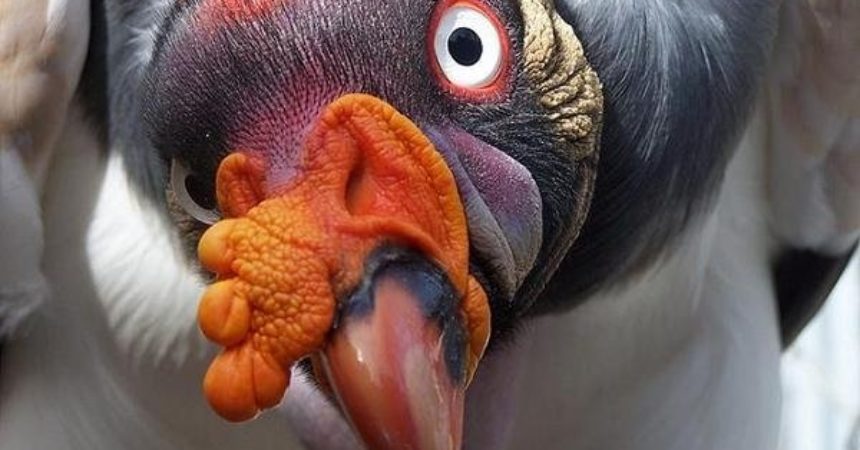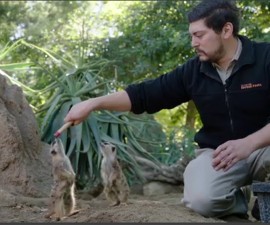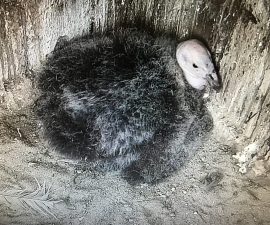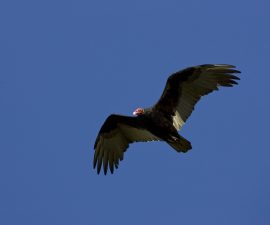A storm was approaching from the mountains, and soon the river would be impossible to cross. Sitting by the river’s edge, I looked up toward the mountains of Costa Rica’s Corcovado National Park as rain clouds hugged the jungle peaks. Soaring high over the lush backdrop was a silhouette—but looking through binoculars, I could make out the distinct white and black contrast of an iconic bird with a five- to six-foot wingspan. It was a king vulture: also known as El Zopilote Rey, or Cozcaquauhtli.
A strikingly handsome bird, the king vulture has white plumage, shading to buff on its back and shoulders. All flight feathers and greater wing coverts are gray-black, as is the thick neck ruff around its shoulders. The skin of its head and neck is bare. The neck is bright orange, shading to yellow on the throat; the head shows a variety of shades of purple, with a red crown. The head skin is folded into a complex series of wrinkles, with a large, bright orange, multi-lobed wattle hanging from the upper mandible. Its beautiful eyes are white, surrounded by a bright red orbital ring. Juveniles are totally gray-black in both plumage and skin color; adult plumage develops slowly over approximately four years.
Although the king vulture is not the Americas’ largest flighted scavenger—that title belongs to condors—the king makes up for it with its statuesque bravado and dreamlike colors. Its strong, curved beak gives the king vulture the ability to tear into the toughest animal hides. Smaller vulture species, like the black vulture, often take advantage of the king’s formidable tearing ability to provide access to a carcass for numerous smaller scavengers.
The king vulture is one Latin America’s most striking species. This large scavenger has a range from southeast Mexico to northern Argentina, favoring lush jungles and forests. Fortunately, the king vulture is not endangered; the International Union for Conservation of Nature Red List of Threatened Species categorizes it as a species of Least Concern. However, global population estimates vary widely, ranging from more than 1,000 to fewer than 50,000 individuals. The population is thought to be declining because of habitat destruction, which is a constant threat to many species that call the rain forests home. Encroaching human populations, poaching, and palm nut farming are but a few of the obstacles these animals face daily. Awareness is only the first step toward protecting them.
The king vulture makes a perfect ambassador for its fellow scavengers. This stunning species has held a place in the hearts and dreams of humankind since the time of the Maya. The Mayan civilization flourished in the rain forests and misty jungles of Central America and southern Mexico from around 300 BC to AD 1520, peaking around AD 800. Their writings were preserved in codices—bark paper books used by Mesoamerican people. Most of the Mayan codices were destroyed by the conquistadors, but four survived the European conquest, and it is in these books that we learn more about the Mayan connection to the king vulture.
On the Mayan Calendar, the Vulture is the 16th Mayan day sign—also known by the name of Cib or Wisdom—and is symbolic of clearing away old karma and inspiring new ways of thinking. Vultures were regarded as teachers and guardians of ancient knowledge, considered to be highly intuitive and able to communicate directly with the spirit. In ancient Maya, the Trecena Cozcaquauhtli was a 13-day period of the calendar dedicated to perfecting the “Way of the Scavenger.” This period signified the wisdom and freedom of old age, representing the path of the setting sun: “while the young heart strategizes between offense and defense, the old heart floats like the clouds, stooping to Earth only to take what no one else wants.”
Vultures and humans share an interwoven history. The Maya revered, honored, and worshipped these crucial birds; however vultures’ connection with death has led some people to a negative perception of these animals. What most don’t realize is that vultures play a major role in prolonging life and health in their environment, helping to eliminate diseases from our ecosystems—including botulism, anthrax, and tuberculosis, to name just a few. These scavengers have powerful stomach acids, which enables them to consume carrion that are laden with toxins that would sicken or kill other animals. They are nature’s recycling centers, providing a pathway from death to life.
Standing at the edge of the river is where I first encountered Cozcaquauhtli—“old heart”—soaring amongst the clouds. It was a powerful experience, and one could easily understand why the Mayan people worshipped this breathtaking, vibrant species. King vultures, and all vultures on Planet Earth, deserve our understanding, appreciation, and respect.
Marco Wendt is a senior keeper at the San Diego Zoo Safari Park. Read his previous post, Honoring Vultures.





